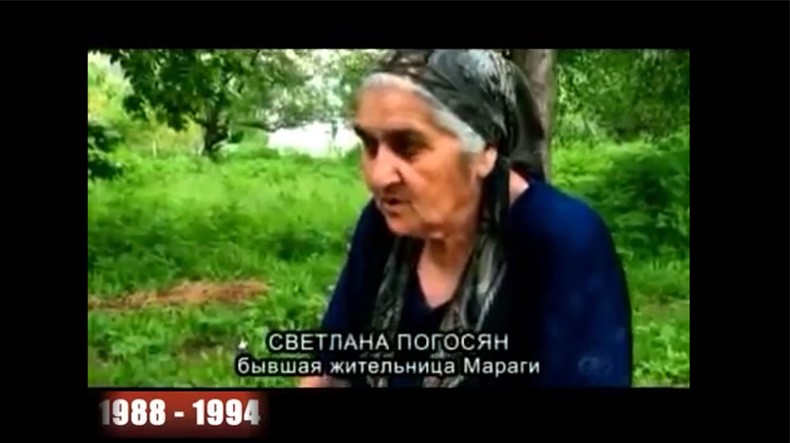
Maragha Genocide eyewitness: Azerbaijanis cruelly tortured my daughter, I do not tell all things I know
On the Maragha Genocide victims commemorative days, Panorama.am presents a series of testimonies of Maragha people.
On April 10, 1992, after a 3-hour artillery preparation, the subunits of the Azerbaijani regular army invaded the peaceful village of Maragha from the Azerbaijani Mir-Bashir (currently Tartar). The attack was not dictated by military necessity. Over 100 people became victims of the aggression – mainly women, children, and old people. Civilians were killed by the most cruel ways: they were partitioned, burnt alive, beheaded, thrown under tanks, or cut with axes. About 50 people were taken hostages, including 9 children. While in captivity, many Maragha residents were tortured, humiliated, and were a subject to an inhuman treatment. Many of them were later exchanged, but the fate of many is still unknown. In about two weeks, on April 22-23, Maraghawas again attacked, people, who had returned to the site of fire, had to leave the native town forever. Currently, Maragha is under Azerbaijani occupation. Baroness Caroline Cox called Maragha “contemporary Golgotha.”
The details of what happened in the once prosperous village 24 years ago, on 10 April 1992, still chill blood, making one doubt whether the perpetrators can have the right to be called human beings. The stories of the survivors, who currently live in the village Nor (New) Maragha, leave no doubt that what happened in the Karabakh village on that day completely matches the definition of genocide provided by a respective UN Convention. Back in 1997, the Armenian side submitted documents and facts about the tragedy in Maragha to the UN Human Rights Committee. The process could not be accomplished then. However, the Armenian side intends to introduce the Maragha dossier to international agencies once again in the frameworks of An Ordinary Genocide project.
The full materials on the topic can be found on karabakhrecords.info and maragha.org.
Svetlana Poghosyan
The firing began in the evening of April 9, 1992. The following day they attacked the village. I hid in a hole and escaped to Magadis village in the evening. Then I came back to Maragha again, where everything was burnt and destroyed. They had slashed and burnt a woman in a way that I could recognize Varya only by the clothes. Her husband was murdered not far from her; they had also killed their daughter and her mother-in-law, and took hostages her two grandchildren. They were exchanged later on.
I was looking for my daughters and then I learned that both of them – Karine with her two children, 2-year-old Narek and infant Lelya, and Zarine with her two children, 4 and 6-year-old – had been taken hostages. On April 17, we learned through the Red Cross that they wanted to exchange Zarine, GezalBarseghyan and children with corpses of the Azerbaijanis. My husband went to exchange. On the way back, they hit a mine and were all wounded: my husband, daughter, and children.
We took them to Martakert hospital. My daughter underwent a serious operation, the pile of her left foot was amputated. However, the wound on her belly turned out to be mortal, and she died the next day. She constantly asked me before the operation, “Mom, what explosion was that? I remember that dad came after us… Where are my children?” I told her that the children were all right and they were alive. One of her sons, 2, had his back wounded, the other, 4, had broken his leg. After the operation, my daughter asked me to bring her children to her. She had been very cruelly tortured during the captivity, her children still do not know about it… I do not tell them much, there are things that only I know. Her chest was entirely burnt with cigarettes, there were two wounds on her neck cut by knife, and lobes of her ears were torn. I asked her the reason, and she said that they had torn the earrings right from her ears and torn the lobes. Before death, Zarine told me that Karine and her mother-in-law were alive. The village was continually under fire but we managed to bury her in the garden of our house.
Up in the mountains, all the villages were abandoned. We stayed there, as it was impossible to live in Maragha because of the firing. I went down 15 kilometers in order to bring food for children. We could not take anything from our property, everything was robbed and burnt.
The recent events in the village Talysh (NKR) also remind of “Maragha.” On April 2, 2016, Azerbaijani divisions, including armed cap-a-pie mercenaries, managed to invade the village. The atrocities committed by them and later photographed by reporters shocked the public. The Azerbaijani saboteurs shot elderly civilians Valera Khalapyan and his wife Razmella, and cut their ears. They also shot the aged and helpless MarusyaKhalapyan (born in 1924).
Related news
- Maragha Genocide eye witness: I never saw again any of people who were in captivity with me in Azerbaijan
- Maragha slaughter anniversary: History repeats itself after 24 years in Karabakh village of Talysh
- Maragha genocide eyewitness: Armenians are Christians, and they have to be murdered
- Maragha massacre eyewitnesses: Dismembered corpses were all around, many people were crushed under tanks
Newsfeed
Videos






























